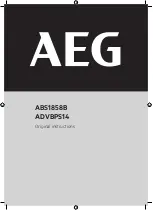
FLOW CONTROL KNOB (Fig. I)
The flow control knob(#19) regulates the amount of liquid that can be sprayed. Turning the
flow knob clockwise increasesthe flow of liquid. Turning the knob counter anti-clockwise
decreases the flow of liquid.
Tip:
Always test the spray pattern on scrap cardboardor similar material first. Begin with flow
control knob on the highest flow setting. If less flow is desired, dial the flow control knob
anti-clockwise to decrease the flow of liquid. Heavier, thicker materials should be sprayed
with the flow control knob on high flow setting. Thinnermaterials should be sprayed with the
flow control knob on low flow setting
DEVELOPING THE PROPER SPRAYING TECHNIQUE
► Practice spraying on a piece of scrap material such ascardboard to test your spray pattern
and becomefamiliar with the flow control feature of the sprayer.
► Ensure the surface to be sprayed is free of dust, dirt, and grease.
► Ensure spray area is clean and free of dust that couldbe blown onto newly sprayed surfac
-
es.
► Cover any areas not intended to be sprayed.
► Always spray from a minimum of 50mm to amaximum of 300mm (Fig. J).
► A commonly used method for spraying a large surface is the “crisscross” pattern. This is
done by spraying in horizontal strips and then crossing over these strips with vertical strips.(-
Fig. L)
► To get an even spray distribution, always keep you rarm at the same distance (Fig. J) from
the surface you are spraying and avoid moving your wrist (Fig. K).
► Maintain smooth and consistent speed which will help avoid inconsistencies. Begin spray
-
ing after the pass has begun and release trigger before stoppingthe pass.
►
Avoid spraying too heavily in any one area. Several lighter coats are better than one
heavy coat which can lead to running and dripping. Remember that theflow control knob
regulates the amount of liquid that can be sprayed. Turning the flow knob clockwise increas-
es the flow of liquid. Turning the knob counter clockwise decreases the flow of liquid. If runs
or drips do occur,have a dry paint brush on hand to smooth them out.
► Turn the power unit off and place the sprayer in the built-in dock of the power unit when
not spraying forany length of time.
CLEANING
► Do not use materials with a flash point higher than 60°C(140°F). Flash point is the
temperature that afluid can produce enough vapors to ignite (see coating supplier).
► Make sure clean up area is well ventilated and free of flam mable vapors.
► Always spray outdoors when spraying cleaning solution through sprayer.
- 18 -
Warning!
Be sure to use appropriate protective gear.
Summary of Contents for SGP17AC
Page 1: ...Model SGP17AC Electric Spray Gun SGP17A C User Manual Electric Spray Gun ...
Page 2: ...1 2 FIG A Electric Spray Gun SGP17AC 01 ...
Page 3: ...FIG A1 FIG A2 30 31 32 33 34 35 36 37 02 ...
Page 4: ...FIG B FIG B1 FIG C FIG D1 03 ...
Page 5: ...FIG F FIG D2 FIG E FIG E1 04 ...
Page 6: ...FIG G FIG H FIG H1 FIG I 8 3 05 ...
Page 7: ...FIG J FIG K FIG L 50 to 300mm 06 ...
Page 8: ...FIG M FIG N FIG O FIG P 07 ...
Page 9: ...FIG Q FIG R FIG Q1 FIG S 36 90 9 08 ...






































